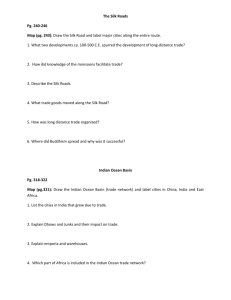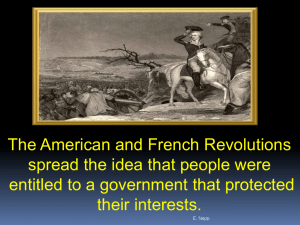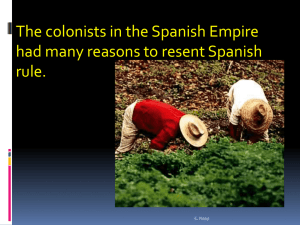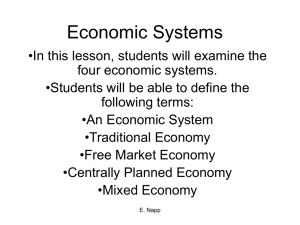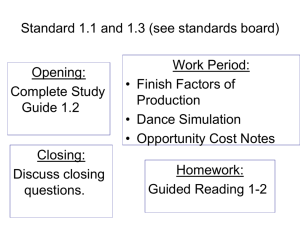Post-Classical Trade Routes: 500 - 1500 CE
advertisement
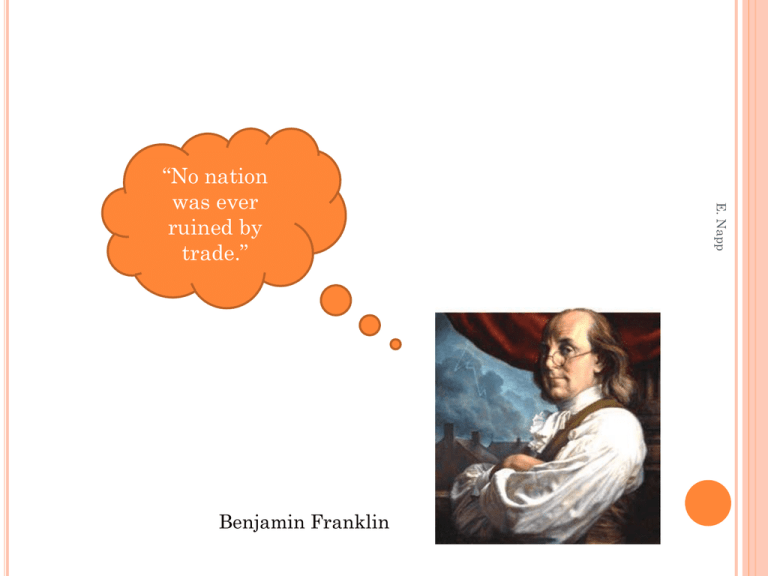
Benjamin Franklin E. Napp “No nation was ever ruined by trade.” THE SILK ROADS One of the world’s most extensive and sustained networks of exchange Land-based trade routes that linked pastoral and agricultural peoples as well as the large civilizations on Eurasia’s outer rim It was more of a “relay trade” in which goods were passed down the line, changing hands many times before reaching their final destination E. Napp E. Napp Outer Eurasia is relatively warm, well-watered, and suitable for agriculture (the civilizations of China, India, the Middle East, and the Mediterranean) Inner Eurasia, the lands of eastern Russia and Central Asia, lies farther north and has a harsher and drier climate -Not conducive to agriculture -Long inhabited by pastoral peoples herding animals from horseback -People had long traded with and raided their agricultural neighbors to the south -Products of the forest and semi-arid northern grasslands known as the steppes included hides, furs, livestock, wool, and amber E. Napp The movement of pastoral peoples also served to diffuse Indo-European languages, bronze metallurgy, horse-based technologies, and more all across Eurasia. E. Napp But from the south, the Persian Empire invaded the territory of pastoral peoples in present-day Turkmenistan and Uzbekistan From the west, Alexander the Great’s empire stretched well into Central Asia From the east, China’s Han dynasty extended its authority westward, seeking to control the nomadic Xiongnu and to gain access to “heavenly horses” that were so important to Chinese military forces E. Napp Silk Road trading networks prospered most when large and powerful states provided security for merchants and travelers. E. Napp Trade flourished during the classical era when the Roman and Chinese empires anchored longdistance commerce at the western and eastern ends of Eurasia. It flourished again during the seventh and eighth centuries CE as the Byzantine Empire, the Muslim Abbasid dynasty, and the Tang Dynasty in China created an almost continuous belt of strong states across Eurasia In the thirteenth and fourteenth centuries, during the Pax Mongolia of the Mongol Empire when the Mongol empire encompassed almost the entire routes of the Silk Roads in a single state, a renewed vitality to long-distance trade occurred E. Napp Most of the goods were luxury products destined for an elite and wealthy market rather than staple goods. Of course, silk came to symbolize this exchange system. E. Napp While the Chinese originally held a monopoly on silk-making, by the sixth century C.E., however, the knowledge and technology for producing raw silk had spread beyond China Eventually, Byzantines, Koreans, Japanese, Indians, and Persians learned how to produce silk Silk was used as currency in Central Asia In China and the Byzantine Empire, silk became a symbol of high status and governments passed laws restricting silk clothing to members of the elite Buddhist monks in China received silk robes from Tang dynasty emperors as a sign of high honor and silk was used for Christian vestments in Western Europe and in wall hangings E. Napp The splendor of Christian churches depended in part on silks imported from the Islamic world, silks which sometimes were even inscribed with passages in Arabic from the Quran, unbeknownst to their European buyers. E. Napp The twelfth-century Persian merchant Ramisht made a personal fortune from his long-distance trading business and with his profits purchased an enormously expensive silk covering for the Kaaba, the central shrine of Islam in Mecca. E. Napp More important than the economic impact of the Silk Roads was their role as a conduit of culture Buddhism in particular, a cultural product of Indian civilization, spread widely throughout Central and East Asia, owing much to the activities of merchants along the Silk Roads -Buddhism had appealed to merchants, who preferred its universal message to that of a Brahmin-dominated Hinduism that privileged the higher castes -Indian traders and Buddhist monks, sometimes supported by rulers such as Ashoka, brought the new religion to the trans-Eurasian trade routes But Persian Zoroastrianism largely blocked the spread of Buddhism to the west, except in the oasis cities of Central Asia, such as Merv, Samarkand, Khotan, and Dunhuang E. Napp In China, Buddhism remained a religion of foreign merchants or foreign rulers. Only slowly did it become popular among the Chinese themselves. E. Napp As Buddhism spread across the Silk Roads from India to Central Asia, China, and beyond, it also changed Its original message had shunned the material world, but Buddhist monasteries in the rich oasis towns of the Silk Roads found themselves very much involved in secular affairs -Some monasteries became wealthy by receiving gifts from merchants and rulers -The begging bowls of monks became a symbol rather than a daily activity Doctrines changed as well -The more devotional Mahayana form of Buddhism flourished on the Silk Roads rather than the more austere psychological teachings of the original Buddha E. Napp E. Napp Buddhism also picked up elements of other cultures on the Silk Roads. In northwest India, statues of the Buddha reveal distinctly Greek influences from the invasions of Alexander the Great while many gods of diverse peoples along the Silk Roads were incorporated into Buddhist bodhisattvas. Diseases traveled the trade routes of Eurasia too Smallpox and measles devastated populations of both the Roman Empire and Han dynasty, contributing to their political collapse -Yet these diseases may have strengthened the appeal of Christianity in Europe and Buddhism in China Bubonic plague ravaged the coastal areas of the Mediterranean Sea between 534 and 750 CE -Disease played a role in preventing Byzantium from reintegrating Italy into its version of a renewed Roman Empire -Repeated recurrence of disease weakened the ability of Christendom to resist the Muslim armies pouring out of Arabia in the seventh century CE E. Napp E. Napp The most well-known dissemination of disease was associated with the Mongol Empire during the thirteenth and fourteenth centuries and the Black Death from China to Europe. Between 1346 and 1350, about one-third of the population of Europe perished from the plague. INDIAN OCEAN TRADE Until the creation of a genuinely oceanic system of trade after 1500, the Indian Ocean represented the world’s largest sea-based system of communication and exchange, stretching from southern China to eastern Asia Transportation costs were lower on the Sea Roads than on the Silk Roads, because ships could accommodate larger and heavier cargoes than camels The monsoons with their alternative wind currents that blew predictably eastward during the summer months and westward during winter made sea-borne trade possible E. Napp Indian Ocean trade operated across an “archipelago of towns” whose merchants had more in common with one another than with the people of their own hinterland. E. Napp Indian Ocean commerce dates back to the time of the First Civilizations Commerce increased in the era of the classical civilizations as mariners learned how to ride the monsoons But the fulcrum of this growing commerce lay in India itself. Indian merchants were in touch with Southeast Asia by the first century CE In the post-classical period, the economic and political revival of China under the Tang and Song dynasties (618-1279) actively promoted trade and the rise of Islam in the seventh century CE and its subsequent spread across much of Afro-Eurasia encouraged commerce within and beyond the creation of an Arab Empire E. Napp Oceanic commerce had a significant impact on Southeast Asia and East Africa, especially the introduction of Hindu, Buddhist, or Islamic beliefs. E. Napp Malay sailors opened an all-sea route between India and China through the Straits of Malacca around 350 CE The Malay kingdom of Srivijaya dominated this critical choke point of Indian Ocean trade from 670 to 1025 -Rulers imported Indian political ideas and Buddhist religious concepts The Sailendra kingdom in central Java, an agriculturally rich region, mounted a massive building program between the eighth and tenth centuries featuring Hindu temples and Buddhist monuments (most famous, known as Borobudur, is the largest Buddhist monument in the world) E. Napp In East Africa, a civilization known as Swahili (also a language) emerged in the eighth century CE, stretching from present-day Somalia to Mozambique But with rise of Islam, increased commerce on western Indian Ocean Between 1000 and 1500 flourished -Independent city-states -Exchanged goods from interior and exchanged for products from distant civilizations -Language was grammatically African within Bantu family but written in Arabic script and containing a number of Arabic loan words -Culture rapidly became Islamic E. Napp Ibn Battuta, the famous Muslim traveler, visited East Africa and West Africa and found many Muslims societies. E. Napp WEST AFRICA Trans-African trade connected North Africa and West Africa, part of sub-Saharan Africa Especially important salt for gold trade Introduction of camel led to initiation of transSaharan commerce by 300 to 400 CE Islam entered West Africa along trade routes Sahara was no longer a barrier The West African kingdoms of Ghana, Mali, and Songhai emerged Sale of slaves from non-Islamic and stateless societies farther south E. Napp E. Napp But far more significant in Europe were slaves from the Slavic-speaking regions along the northern coast of the Black Sea. They were so numerous that the word “slave” in many European languages derives from the term “Slav.” The states of Sudanic Africa developed substantial urban and commercial centers – such as KoumbiSaleh, Jenne, Timbuktu, Gao, Gobir, and Kano. E. Napp E. Napp In the Americas, geographic factors (mountains and rain forests) added obstacles to trade. The north/south orientation of the Americas slowed the spread of agricultural products due to differing climatic zones but nonetheless, there was “a loosely interactive web stretching from the North American Great Lakes and upper Mississippi south to the Andes” and there were also trade within powerful empires (Mayas, Aztecs, Incas). STRAYER QUESTIONS What lay behind the emergence of Silk Road commerce, and what kept it going for so many centuries? What made silk such a highly desired commodity across Eurasia? What were the major economic, social, and cultural consequences of Silk Road commerce? What accounted for the spread of Buddhism along the Silk Road? What was the impact of disease along the Silk Road? E. Napp E. Napp How did the operation of the Indian Ocean trading network differ from that of the Silk Roads? What lay behind the flourishing of Indian Ocean commerce in the postclassical millennium? What is the relationship between the rise of Srivijaya and the world of Indian Ocean commerce? What was the role of Swahili civilization in the world of Indian Ocean commerce? What changes did trans-Saharan trade bring to West Africa? In what ways did networks of interaction in the Western Hemisphere differ from those in the Eastern Hemisphere?
